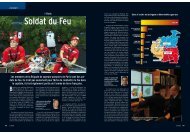Joint Publication 3-13, Information Operations - The Global ...
Joint Publication 3-13, Information Operations - The Global ...
Joint Publication 3-13, Information Operations - The Global ...
You also want an ePaper? Increase the reach of your titles
YUMPU automatically turns print PDFs into web optimized ePapers that Google loves.
Introduction<br />
legal issues, as well as potentially disruptive infrastructure issues, through civil-military coordination at all<br />
levels.<br />
(1) IO may target human decision making or automated decision support systems<br />
with specific actions. Technology allows automated decision making to be targeted with<br />
increasing precision and affords more sophisticated ways to protect it. However, targeting<br />
automated decision making, at any level, is only as effective as the human adversary’s<br />
reliance on such decisions.<br />
(2) <strong>The</strong> focus of IO is on the decision maker and the information environment in order<br />
to affect decision making and thinking processes, knowledge, and understanding of the situation.<br />
IO can affect data, information, and knowledge in three basic ways:<br />
(a) By taking specific psychological, electronic, or physical actions that add,<br />
modify, or remove information from the environment of various individuals or groups of decision<br />
makers.<br />
(b) By taking actions to affect the infrastructure that collects, communicates,<br />
processes, and/or stores information in support of targeted decision makers.<br />
(c) By influencing the way people receive, process, interpret, and use data,<br />
information, and knowledge.<br />
h. All IO capabilities may be employed in both offensive and defensive operations.<br />
Commanders use IO capabilities in both offensive and defensive operations simultaneously to<br />
accomplish the mission, increase their force effectiveness, and protect their organizations and<br />
systems. Fully integrating IO capabilities for offensive and defensive operations requires planners<br />
to treat IO as a single function. Commanders can use IO capabilities to accomplish the following:<br />
(1) Destroy. To damage a system or entity so badly that it cannot perform any function<br />
or be restored to a usable condition without being entirely rebuilt.<br />
(2) Disrupt. To break or interrupt the flow of information.<br />
(3) Degrade. To reduce the effectiveness or efficiency of adversary C2 or<br />
communications systems, and information collection efforts or means. IO can also degrade the<br />
morale of a unit, reduce the target’s worth or value, or reduce the quality of adversary decisions<br />
and actions.<br />
(4) Deny. To prevent the adversary from accessing and using critical information,<br />
systems, and services.<br />
(5) Deceive. To cause a person to believe what is not true. MILDEC seeks to mislead<br />
adversary decision makers by manipulating their perception of reality.<br />
I-9



